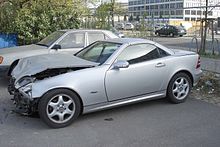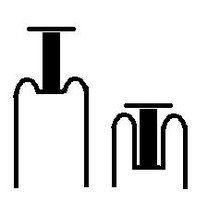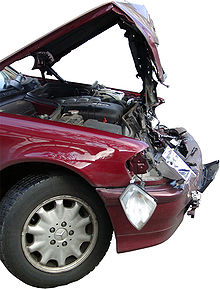Crumple zone
The term crumple zone refers to areas of a vehicle that deform in the event of a collision and thus absorb energy through deformation work. The term first became known in automotive engineering, but it has since been used in other areas, such as rail vehicles and aircraft construction. The crumple zone can be traced back to a patent filed on January 23, 1951, and granted on August 28, 1952, by engineer Béla Barényi, entitled "Motor vehicles, in particular for the transport of persons." The first vehicle model built according to this concept (division of the body into three "boxes": soft front end, rigid passenger cell, soft rear end) was the 1959 Mercedes-Benz W 111 ("tail fin").
In the early days of automotive engineering, vehicles were designed to be as rigid as possible so that in the event of a collision with an obstacle or another vehicle, there was often little deformation of the car itself (frame design). As a result, the occupants were subjected to enormous delays. The idea of the crumple zone aims to reduce the acceleration acting on the occupants and can be derived from the equation for work.
In the event of a crash, the kinetic energy contained in the vehicle is converted into deformation energy. The work done (energy change) Δ 


with negative acceleration at impact assumed constant in an idealized manner. The energy to be converted to standstill is given by the kinetic energy of the vehicle moving at speed
Equate gives the (negative) acceleration for a given length of crumple zone and speed:

Crumple zone after laterally offset front impact

Deformed crumple zone in a Mercedes-Benz R170; the passenger cell is still intact here
Deformation zones (crumple zones)
The deformation zones of an automobile can be divided into front, side and rear.
- Front: In frontal collisions, the highest relative speeds to the obstacle usually occur, which is why the design of the front end is of the greatest importance. In most automobiles, this area contains the engine, which is practically non-deformable despite the high forces that occur and therefore does not absorb any energy. Most of the energy is absorbed by the cross members, which are usually hollow sections made of sheet steel. Among other things, longitudinal members are used to ensure that forces are distributed as evenly as possible, even on structures on the side away from the impact, in the event of uneven force application (offset crash, vehicle hits an obstacle with only part of the front end).
- Side: In the case of an impact from the side, only a very small deformation path is available, and at the same time the structure is mainly subjected to bending, both of which are disadvantageous for energy absorption. The side impact is therefore the most critical form of impact. The door contains parts such as speakers, window lifting and door closing mechanisms. To prevent these parts from entering the passenger compartment, an appropriate interior door panel is used. Side airbags act as an internal deformation zone between the passenger and the side wall.
- Rear: The rear impact is quite unproblematic, since the relative speeds to the obstacle are usually rather low and there is a large deformation path free of interfering elements such as an engine block. Only the fuel tank is normally located in the rear. In order to achieve the legally required tightness of fuel systems, the tank is located as far forward and downward as possible, often under the rear seat bench.
In modern automobiles, the body is specifically designed for crash performance. The front of the vehicle can be roughly divided into three zones:
- The first area is designed to prevent permanent damage to the vehicle in the event of low-speed collisions, e.g. parking bumps. This is achieved by elastic elements, such as the front bumper, among others. In some vehicles, the bumper is filled with foam or similar elastic materials for this purpose.
- In the case of less severe collisions (up to around 20 km/h), the second area is intended to ensure that the vehicle's load-bearing structure is not damaged and that repairs can be carried out as cost-effectively as possible. Among other things, so-called crash tubes or crash boxes are used for this purpose. Crash tubes consist of a hollow steel profile which converts the impacting energy by rolling up the profile. The picture shows the undeformed crash tube on the left and the rolled-up one on the right.
- The third area is the so-called survival space, which is designed with maximum rigidity to ensure the survival of the occupants.
Accordingly, zones 1 and 2 fall under the crumple zone category.

schematic sketch crash tube

Crumple zone after an accident
Compatibility
Compatibility is the attempt to keep the risk of injury as low as possible for all parties involved, even in the case of unequal accident opponents (e.g. heavy sedan against small car, but also car against pedestrian/bicyclist, etc.). Put simply, this works according to the principle: the larger and heavier the vehicle, the softer the deformation zones. This means that, for example, in the event of a collision between a small car and a heavier, larger vehicle, the latter absorbs the greater part of the kinetic energy of both vehicles, as it generally has a considerably larger deformation path at its disposal. Thus, the risk of injury to the occupants of the smaller vehicle is not significantly increased compared to the occupants of the heavier car. However, this development is still relatively new.
Greater public attention regarding the unequal mass ratios of vehicles of different classes in an accident was generated by a crash test in the mid-1990s, in which a Mercedes-Benz S-Class sedan (W 140) collided with an Opel Corsa B. The crash test was conducted in the same year. After the frontal crash with 50/50 overlap of the vehicles, only marginal deformation was evident on the S-Class, while the Corsa's crumple zone collapsed completely, resulting in damage to the passenger cell. In response to these test results, Mercedes extensively adapted its occupant protection to the compatibility and requirements of collisions with smaller vehicles.
See also
- Crashbox
Search within the encyclopedia



